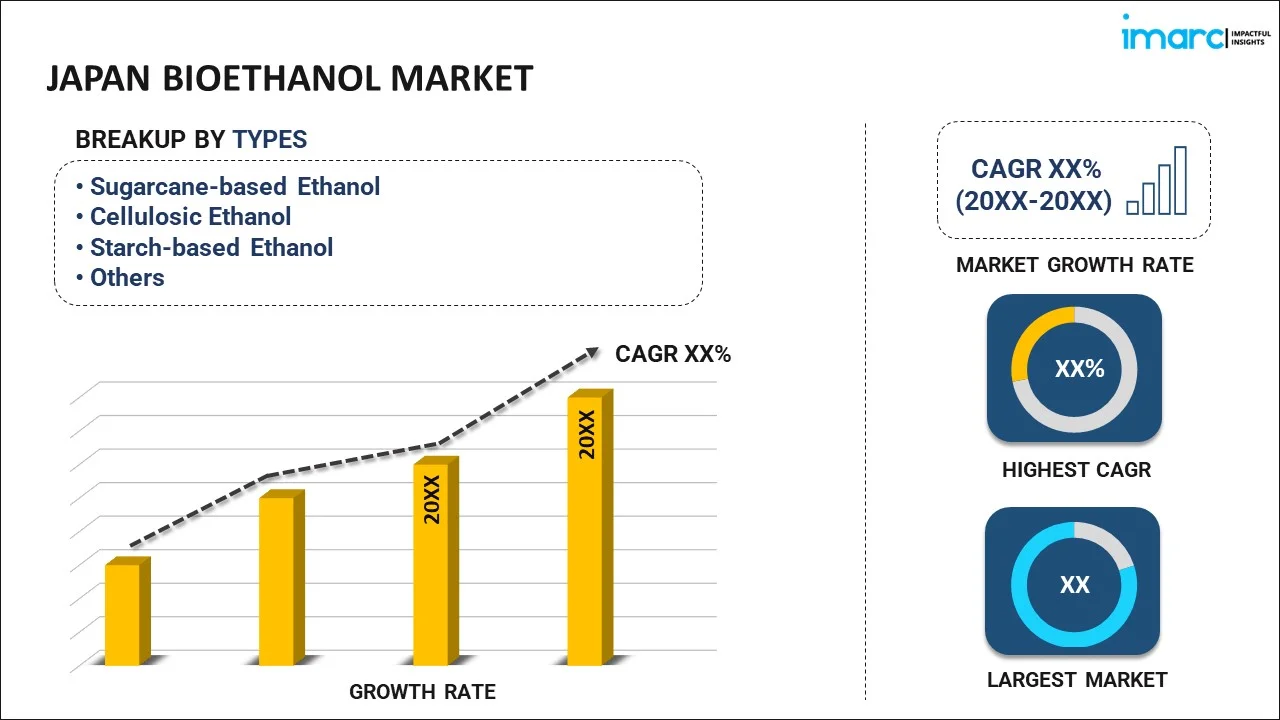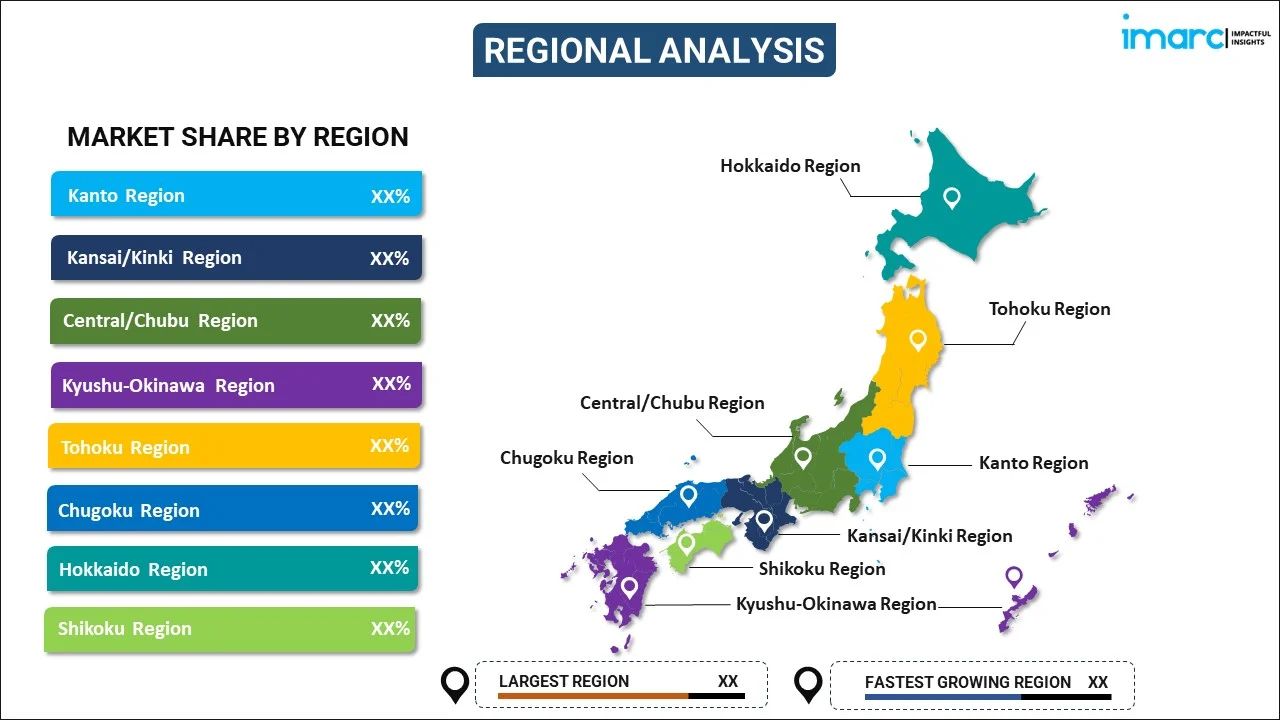
Japan Bioethanol Market Report by Type (Sugarcane-based Ethanol, Cellulosic Ethanol, Starch-based Ethanol, and Others), Fuel Blend (E10, E20 and E25, E70 and E75, E85, and Others), Generation (First Generation, Second Generation, Third Generation), End Use Industry (Automotive and Transportation, Power Generation, Pharmaceutical, Food and Beverage, Cosmetics and Personal Care, and Others), and Region 2025-2033
Market Overview:
Japan bioethanol market size reached USD 261.7 Million in 2024. Looking forward, IMARC Group expects the market to reach USD 497.5 Million by 2033, exhibiting a growth rate (CAGR) of 6.7% during 2025-2033. The inflating need for eco-friendly alternatives to fossil fuels, owing to the growing consumer environmental concerns, is primarily driving the market growth.
|
Report Attribute
|
Key Statistics
|
|---|---|
|
Base Year
|
2024 |
|
Forecast Years
|
2025-2033
|
|
Historical Years
|
2019-2024
|
| Market Size in 2024 | USD 261.7 Million |
| Market Forecast in 2033 | USD 497.5 Million |
| Market Growth Rate (2025-2033) | 6.7% |
Bioethanol is a transparent, colorless liquid derived from biomass through processes like hydrolysis and sugar fermentation or by chemically reacting ethylene with steam. Unlike conventional fuels, it is biodegradable, less harmful to the environment, and does not contribute to pollution. As a result, it is gaining popularity as a substitute for traditional gasoline in road transportation vehicles worldwide. Bioethanol can be seamlessly blended with gasoline, requiring no modifications to existing engine designs, resulting in reduced greenhouse gas (GHG) emissions and decreased air pollution.
Japan Bioethanol Market Trends:
The Japan bioethanol market is experiencing significant growth, driven by a multitude of influential factors. Firstly, the global trend of suburbanization, coupled with the rising incomes of individuals, is contributing to increased sales of passenger vehicles. This has a direct impact on the demand for bioethanol as a more environmentally friendly alternative to traditional fossil fuels. Furthermore, growing environmental concerns among the populace are propelling the adoption of bioethanol as a means to reduce carbon emissions and air pollution. Improved road transport networks have also led to an upsurge in the usage of commercial vehicles, which are a significant source of air pollution. In response, governments in various countries, including Japan, are imposing stringent regulations to curb pollutant emissions and promote the use of this compound. Bioethanol's application extends beyond transportation fuel. It is known for its skin-friendly and environmentally harmless properties, making it a sought-after ingredient in cosmetics and personal care products worldwide. Additionally, it plays a vital role in the pharmaceutical industry, being used in the formulation of drugs, cough syrups, medicinal capsules, and disinfectants. In the food and beverage (F&B) sector, bioethanol is gaining traction as a flavor enhancer. These diverse applications underscore the versatile and growing significance of bioethanol in Japan's market and beyond over the forecasted period.
Japan Bioethanol Market Segmentation:
IMARC Group provides an analysis of the key trends in each segment of the market, along with forecasts at the country level for 2025-2033. Our report has categorized the market based on type, fuel blend, generation, and end use industry.
Type Insights:

- Sugarcane-based Ethanol
- Cellulosic Ethanol
- Starch-based Ethanol
- Others
The report has provided a detailed breakup and analysis of the market based on the type. This includes sugarcane-based ethanol, cellulosic ethanol, starch-based ethanol, and others.
Fuel Blend Insights:
- E10
- E20 and E25
- E70 and E75
- E85
- Others
A detailed breakup and analysis of the market based on the fuel blend have also been provided in the report. This includes E10, E20 and E25, E70 and E75, E85, and others.
Generation Insights:
- First Generation
- Second Generation
- Third Generation
The report has provided a detailed breakup and analysis of the market based on the generation. This includes first generation, second generation, and third generation.
End Use Industry Insights:
- Automotive and Transportation
- Power Generation
- Pharmaceutical
- Food and Beverage
- Cosmetics and Personal Care
- Others
A detailed breakup and analysis of the market based on the end use industry have also been provided in the report. This includes automotive and transportation, power generation, pharmaceutical, food and beverage, cosmetics and personal care, and others.
Regional Insights:

- Kanto Region
- Kansai/Kinki Region
- Central/ Chubu Region
- Kyushu-Okinawa Region
- Tohoku Region
- Chugoku Region
- Hokkaido Region
- Shikoku Region
The report has also provided a comprehensive analysis of all the major regional markets, which include Kanto Region, Kansai/Kinki Region, Central/ Chubu Region, Kyushu-Okinawa Region, Tohoku Region, Chugoku Region, Hokkaido Region, and Shikoku Region.
Competitive Landscape:
The market research report has also provided a comprehensive analysis of the competitive landscape. Competitive analysis such as market structure, key player positioning, top winning strategies, competitive dashboard, and company evaluation quadrant has been covered in the report. Also, detailed profiles of all major companies have been provided.
Japan Bioethanol Market Report Coverage:
| Report Features | Details |
|---|---|
| Base Year of the Analysis | 2024 |
| Historical Period | 2019-2024 |
| Forecast Period | 2025-2033 |
| Units | Million USD |
| Scope of the Report | Exploration of Historical Trends and Market Outlook, Industry Catalysts and Challenges, Segment-Wise Historical and Future Market Assessment:
|
| Types Covered | Sugarcane-based Ethanol, Cellulosic Ethanol, Starch-based Ethanol, Others |
| Fuel Blends Covered | E10, E20 and E25, E70 and E75, E85, Others |
| Generations Covered | First Generation, Second Generation, Third Generation |
| End Use Industries Covered | Automotive and Transportation, Power Generation, Pharmaceutical, Food and Beverage, Cosmetics and Personal Care, Others |
| Regions Covered | Kanto Region, Kansai/Kinki Region, Central/ Chubu Region, Kyushu-Okinawa Region, Tohoku Region, Chugoku Region, Hokkaido Region, Shikoku Region |
| Customization Scope | 10% Free Customization |
| Post-Sale Analyst Support | 10-12 Weeks |
| Delivery Format | PDF and Excel through Email (We can also provide the editable version of the report in PPT/Word format on special request) |
Key Questions Answered in This Report:
- How has the Japan bioethanol market performed so far and how will it perform in the coming years?
- What has been the impact of COVID-19 on the Japan bioethanol market?
- What is the breakup of the Japan bioethanol market on the basis of type?
- What is the breakup of the Japan bioethanol market on the basis of fuel blend?
- What is the breakup of the Japan bioethanol market on the basis of generation?
- What is the breakup of the Japan bioethanol market on the basis of end use industry?
- What are the various stages in the value chain of the Japan bioethanol market?
- What are the key driving factors and challenges in the Japan bioethanol?
- What is the structure of the Japan bioethanol market and who are the key players?
- What is the degree of competition in the Japan bioethanol market?
Key Benefits for Stakeholders:
- IMARC’s industry report offers a comprehensive quantitative analysis of various market segments, historical and current market trends, market forecasts, and dynamics of the Japan bioethanol market from 2019-2033.
- The research report provides the latest information on the market drivers, challenges, and opportunities in the Japan bioethanol market.
- Porter's five forces analysis assist stakeholders in assessing the impact of new entrants, competitive rivalry, supplier power, buyer power, and the threat of substitution. It helps stakeholders to analyze the level of competition within the Japan bioethanol industry and its attractiveness.
- Competitive landscape allows stakeholders to understand their competitive environment and provides an insight into the current positions of key players in the market.
Need more help?
- Speak to our experienced analysts for insights on the current market scenarios.
- Include additional segments and countries to customize the report as per your requirement.
- Gain an unparalleled competitive advantage in your domain by understanding how to utilize the report and positively impacting your operations and revenue.
- For further assistance, please connect with our analysts.

 Inquire Before Buying
Inquire Before Buying
 Speak to an Analyst
Speak to an Analyst
 Request Brochure
Request Brochure
 Request Customization
Request Customization



.webp)




.webp)












